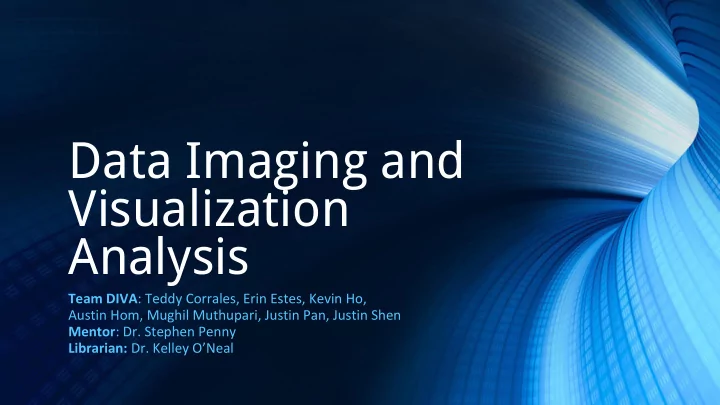

Data Imaging and Visualization Analysis Team DIVA : Teddy Corrales, Erin Estes, Kevin Ho, Austin Hom, Mughil Muthupari, Justin Pan, Justin Shen Mentor : Dr. Stephen Penny Librarian: Dr. Kelley O’Neal
Overview • Background • Past Research • 2-D maps → 3-D maps • Our solution: Virtual Reality • Research Questions • Methodology (3 Phases) • Product Development (current) • Product Improvement • Product Evaluation
(NASA, n.d.) Motivation for Our Project • Terabytes of climate data • Current visualization and analysis methods are inadequate and not interactive • Difficult to … • View multiple variables • Observe correlations • Zoom in on areas of interest
Past Research: Current Visualization Methods
2-D Color Maps Mean Surface Temperature. TImeframe unknown (Potter at al., 2009).
Two-variable Colored Maps 2-D map of relative humidity and temperature (Teuling et al., 2011).
Glyph Maps Glyph map of temperature across a region (Wickham et al., 2012).
3-D Globes Tropical cyclone visualized in World Wind globe API (Liu et al., 2015).
Solution Visualize and Analyze Data with Virtual Reality (VR) (Koutek, M., & Post, F., n.d.)
Research Questions
Research Questions • In terms of computation time, feature selection, and storage, how can we most effectively design and create a Virtual Reality climate data visualization tool? • What are the most user-friendly, aesthetically pleasing and informative ways for scientists and the general public to visualize climate data through VR?
Methodology
Phase I - Product Development: Oculus Rift Overview • Most widely used VR device with cutting-edge capabilities • Head- and Position-tracking • Enhanced interactivity of Oculus Touch • Available in the MakerSpace in McKeldin (Turbosquid,. 2015)
Phase I - Product Development: System Overview Control Flow for Cloud-based Climate Data Visualization Tool User’s Oculus Handles input from controller and output to screen. User sends query (Climate data The interface sends this image file, visualization parameters). to user’s Oculus. Web interface Handles communications between user’s Oculus and remote GPUs. GPU cluster returns rendered Interface forwards query to GPU image to interface in real time. cluster. GPU cluster Handles processing of big data so that user’s machine does not have to.
Unreal Engine 4 Overview • Uses unmodified C++ • Advantages: • netCDF library written in C → simple integration • More potential for better graphics in visualization • “Blueprint” mode • Disadvantages: • Resource intensive - especially processor speed and graphics
Phase I - Product Development: Current Progress Current Progress Future Goals • Ability to display multiple variables • Volumetric 3D rendering for height fields • Tools to identify meaningful correlations among data • Interface with maps and GIS data from library resources • Adjustable color schemes Able to read in and display an entire netCDF file of one variable
Phase II - Product Improvement: Focus Groups First Focus Group Second Focus Group Third Focus Group Who Who Who 5 graphics experts from 30 students from UMD 10 climate experts from UMD faculty NOAA/NASA and UMD Broken into 5 groups of 6 Goal Goal Goal To refine aesthetics To get broad To get feedback with and user interface feedback on usability respect to climate visualization
Phase III - Product Evaluation: Individual Surveys • Convenience Surveys: Rate our product compared a traditional visualization • 50 new participants from the general public • Targeted Surveys: Given a specific task, record time required • 10 research experts
Future Plans
Acknowledgements Dr. Stephen Penny (Mentor) Dr. Kelley O’Neal (Librarian) Dr. Kristan Skendall, Dr. Frank Coale, Vickie Hill (Gemstone Staff) The Library Spaces at UMD
Questions? (Turbosquid, 1. 2015)
References Image Sources: Koutek, M., & Post, F. (n.d.). Virtual Reality for Data Visualization. Retrieved November 06, 2016, from http://graphics.tudelft.nl/~michal/vr_demos/ Liu, P., Gong, J., & Yu, M. (2015). Visualizing and analyzing dynamic meteorological data with virtual globes: A case study of tropical cyclones. Environmental Modelling & Software, 64, 80-93. NASA (n.d.). Retrieved November 06, 2016, from http://climate.nasa.gov/nasa_science/missions/ Potter, K., Wilson, A., Bremer, P. T., Williams, D., Doutriaux, C., Pascucci, V., & Johhson, C. (2009). Visualization of uncertainty and ensemble data: Exploration of climate modeling and weather forecast data with integrated ViSUS-CDAT systems. In Journal of Physics: Conference Series (Vol. 180, No. 1, p. 012089). IOP Publishing. Teuling, A. J., Stöckli, R., & Seneviratne, S. I. (2011). Bivariate colour maps for visualizing climate data. International Journal of Climatology, 31(9), 1408-1412. Turbosquid. (2015). Oculus Rift and Touch. Retrieved November 06,2016, from http://www.turbosquid.com/3d-models/3ds-max-oculus-rift-touch/94267 Wickham, H., Hofmann, H., Wickham, C., & Cook, D. (2012). Glyph-maps for visually exploring temporal patterns in climate data and models. Environmetrics, 23(5), 382-393.
Recommend
More recommend